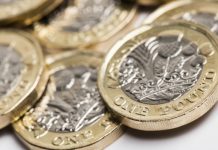Last week, the pound US dollar exchange rate dropped close to 2.5% for the pound, as UK political stability continued to weigh on sterling. Meanwhile, the dollar was boosted by strong data and increased hopes of an interest rate rise. The pound US dollar exchange plunged to a low of US$1.3028 for GBP on Friday, before picking up into the close. This is sterling’s weakest level versus the dollar in 2 months.
| What do these figures mean? |
|---|
|
When measuring the value of a pair of currencies, one set equals 1 unit and the other shows the current equivalent. As the market moves, the amount will vary from minute to minute. For example, it could be written: 1 GBP = 1.28934 USD Here, £1 is equivalent to approximately $1.29. This specifically measures the pound’s worth against the dollar. If the US dollar amount increases in this pairing, it’s positive for the pound. Or, if you were looking at it the other way around: 1 USD = 0.77786 GBP In this example, $1 is equivalent to approximately £0.78. This measures the US dollar’s worth versus the British pound. If the sterling number gets larger, it’s good news for the dollar. |
Politics drove the pound last week. UK Prime Minister Theresa May’s leadership seemed to be in danger, which caused the pound to plummet. Pound traders feared a distracting leadership contest during the Brexit negotiations would throw the tight Brexit timetable off track. However, by late Friday afternoon, Theresa May made it clear she wouldn’t be stepping down. Her comments eased concerns among traders and a relief rally boosted the pound versus the euro.
| How does political stability boost a currency? |
|---|
| Political stability boosts both consumer and business confidence, which means corporations and regular households alike are more likely to spend money. The increased spending, in turn, then boosts the economy. Foreign investors prefer to invest their money in politically stable countries as well as those with strong economies. For foreign investors to put their money into an economy, they need local currency. As they acquire the money needed, the demand for that particular currency increases, which then boosts its value. |
Politics look set to remain a key factor for the pound today, as the fifth round of Brexit negotiations are due to start in Brussels. Theresa May is expected to give a strong ultimatum to EU leaders to try to get them to make the next move and unlock the negotiation deadlock which appears to be forming once again. Brexit headlines could cause significant volatility, and any signs of no deal being reached could see the pound tumble.
Mixed US payrolls
The US dollar moved sharply higher last week, however, a mixed jobs report on Friday, pulled the buck lower into the close. The Labour department’s jobs report showed that 33,000 jobs were lost in the US in September, significantly lower than the increase of 80,000 jobs that analysts had expected. While this shocking figure was somewhat distorted due to the summer hurricanes in the US, investors were still not impressed. Even news that US unemployment dropped to 4.2% from 4.4% failed to lift investors’ spirits. Additional news that average wages unexpectedly increased by 0.5% month on month, stronger than the 0.3% forecast by analysts, also failed to boost dollar hopes. Average wage increase is a strong sign that inflation could soon be on the way up, which would normally boost the dollar.
| How does the non-farm payroll (NFP) affect the US dollar? |
|---|
| It works like this, when there is low unemployment and high job creation, the demand for workers increases. As demand for workers goes up, wages for those workers also go up. Which means the workers are now taking home more money to spend on cars, houses or in the shops. As a result, demand for goods and services also increase, pushing the prices of the good and services higher. That’s also known as inflation. When inflation moves higher, central banks are more likely to raise interest rates, which then pushes up the currency’s worth. |
Looking out across the week, the two big events for the dollar will be the release of the minutes of the US Federal Reserve 20th September policy meeting on Wednesday, and then US inflation data on Friday. The probability of the Fed hiking rates in December is currently at 90%. Should inflation start to show signs of ticking higher and the Fed stick to the view that they are ready to hike rates, the dollar could then be in for another stellar week versus the pound.
|
This article was initially published on TransferWise.com from the same author. The content at Currency Live is the sole opinion of the authors and in no way reflects the views of TransferWise Inc. |





